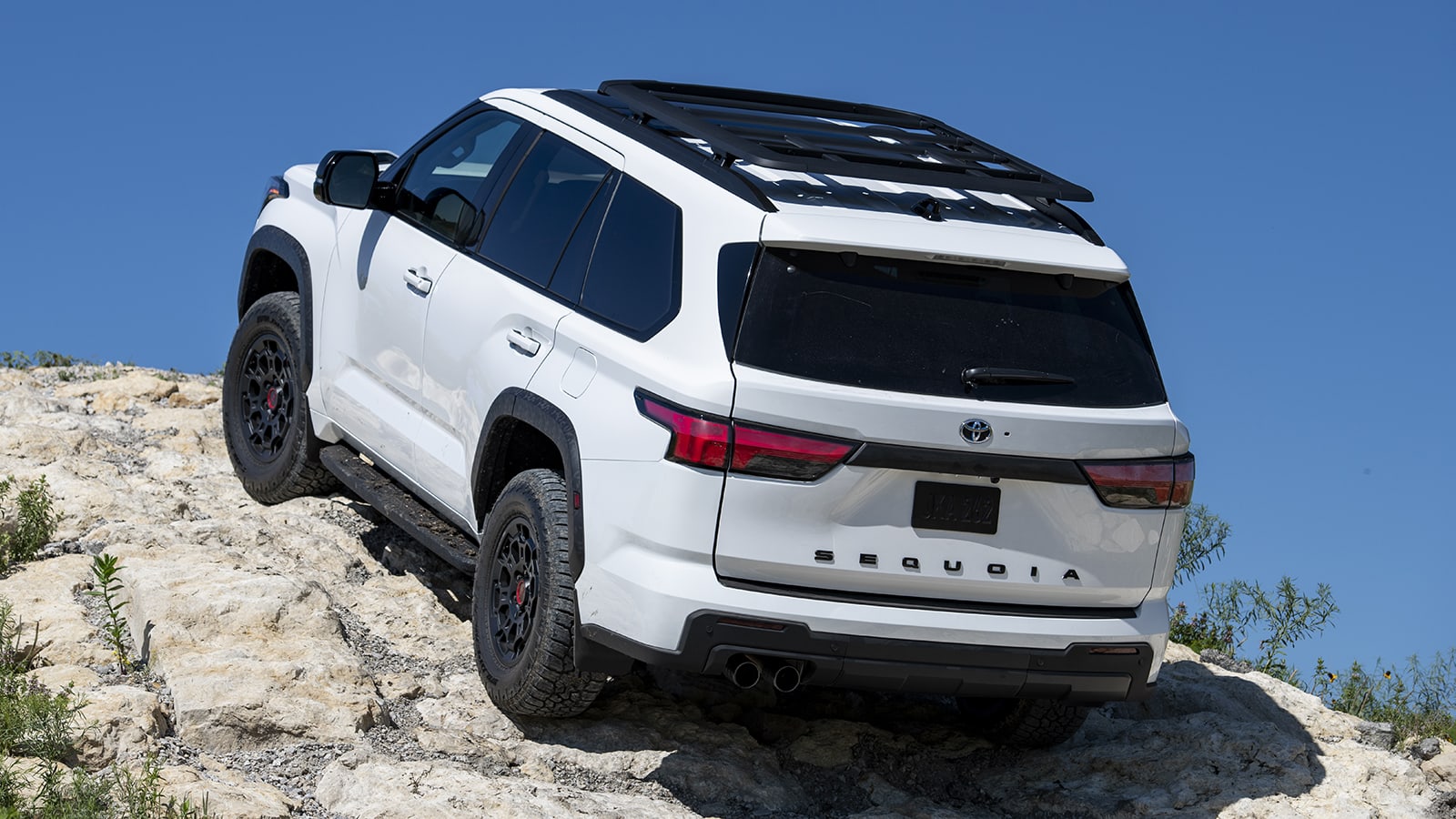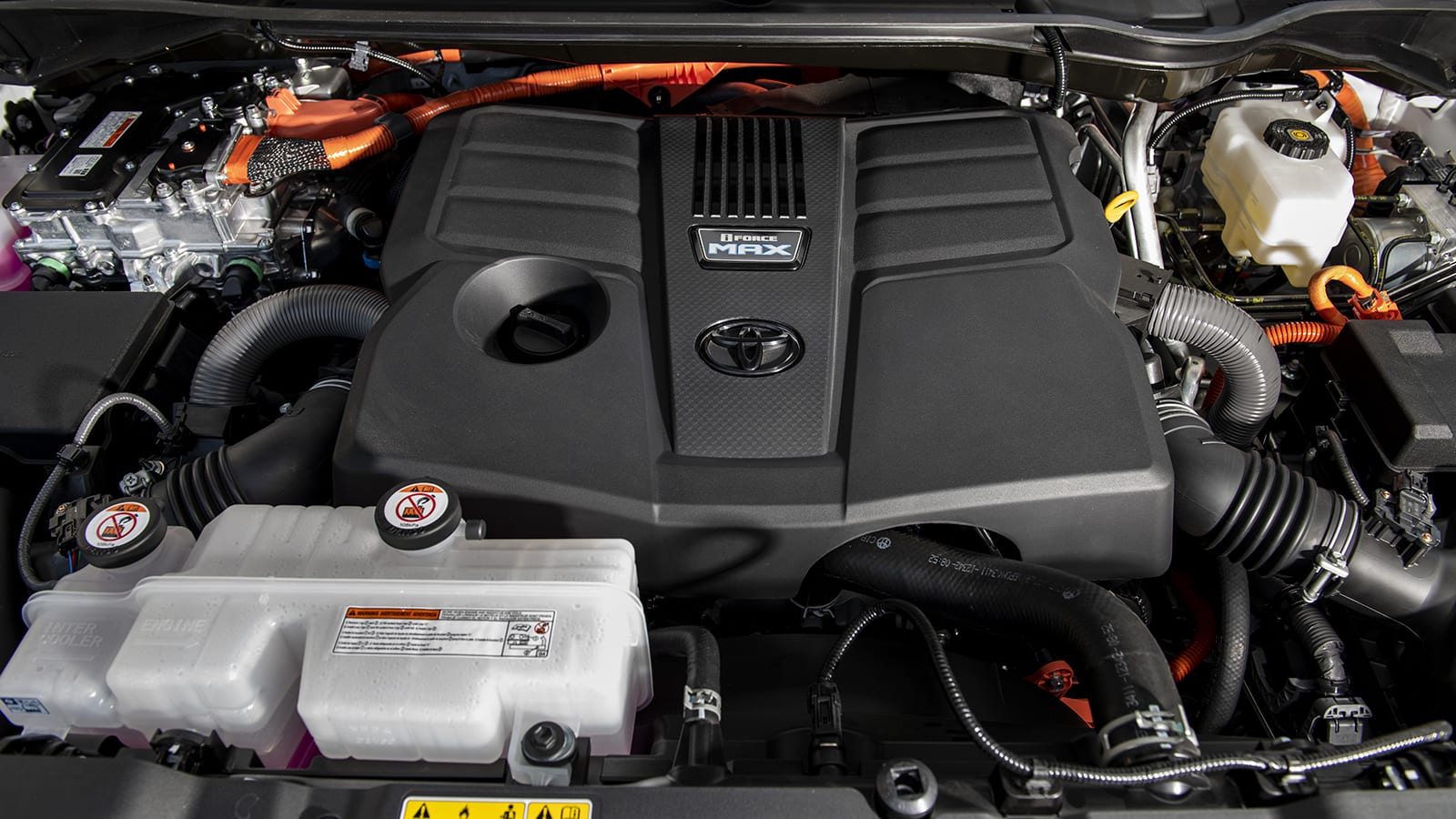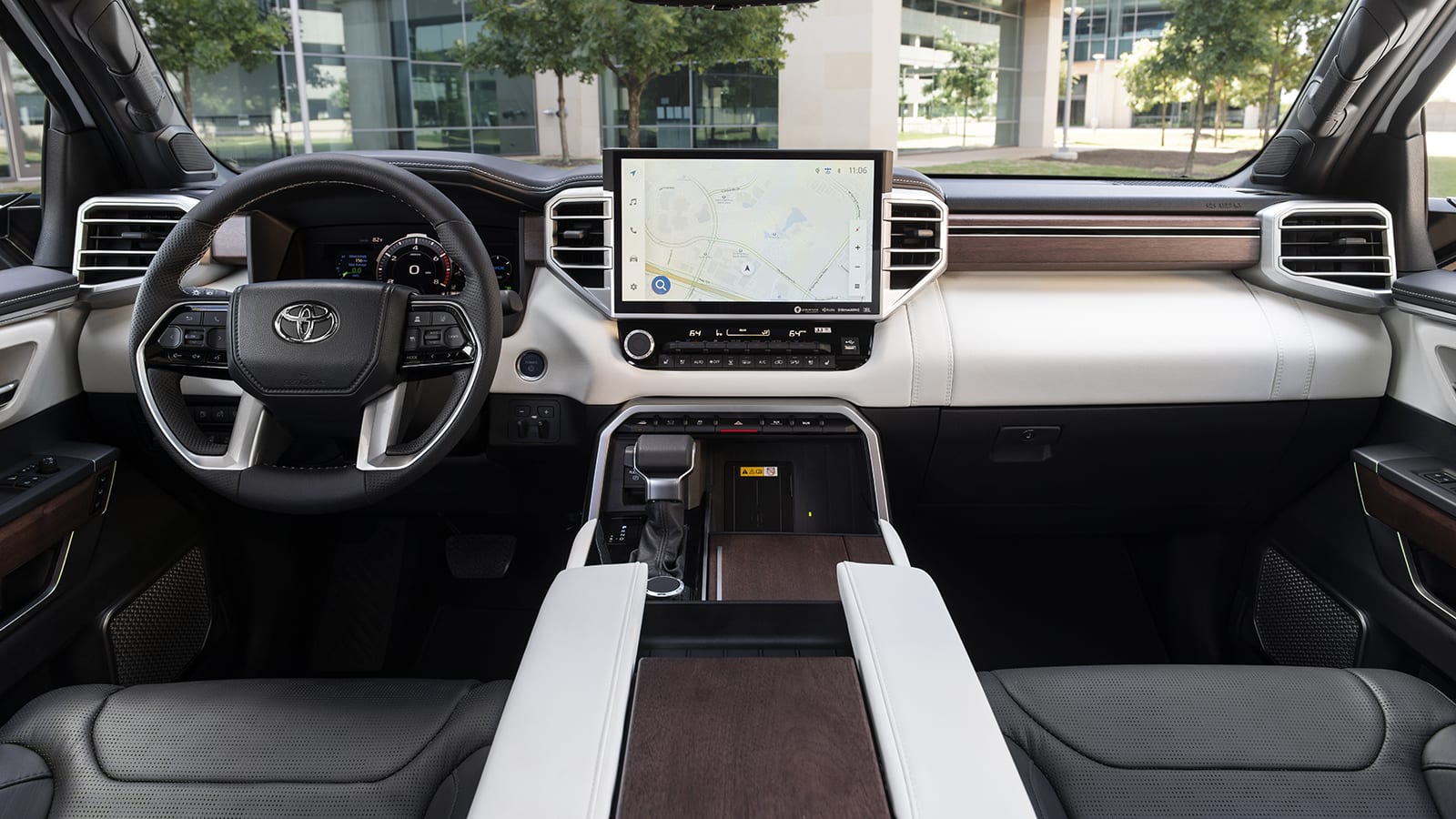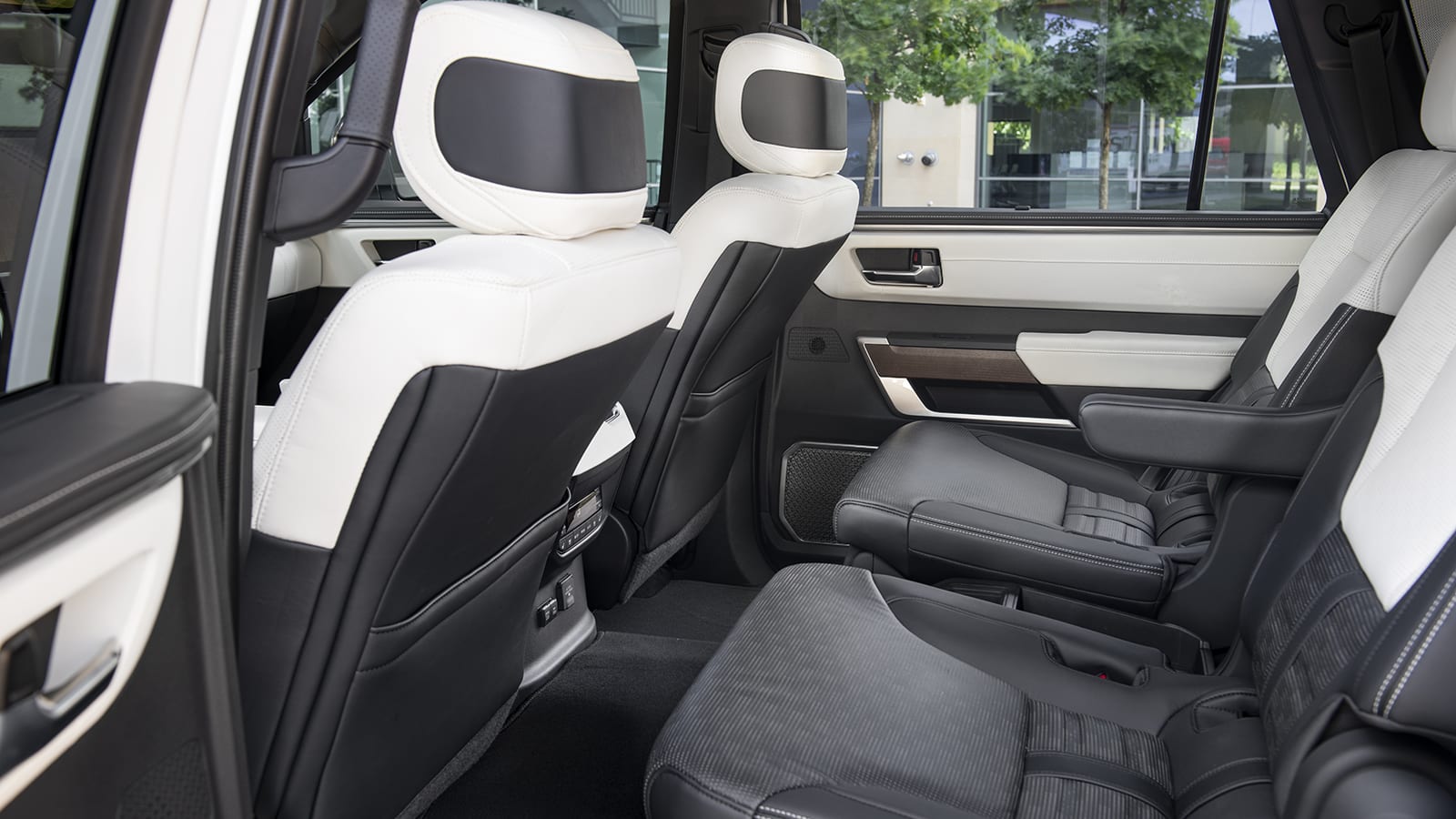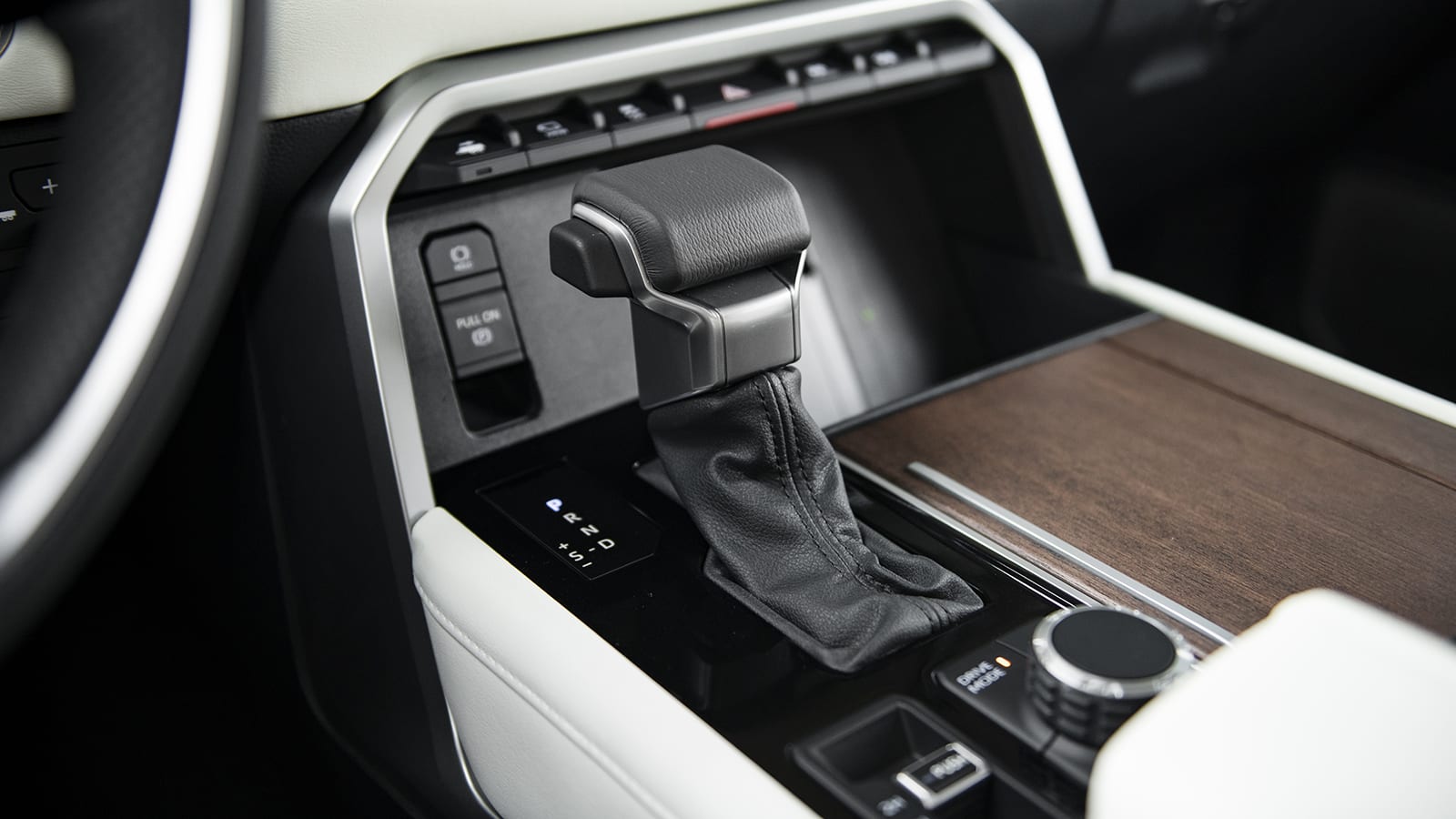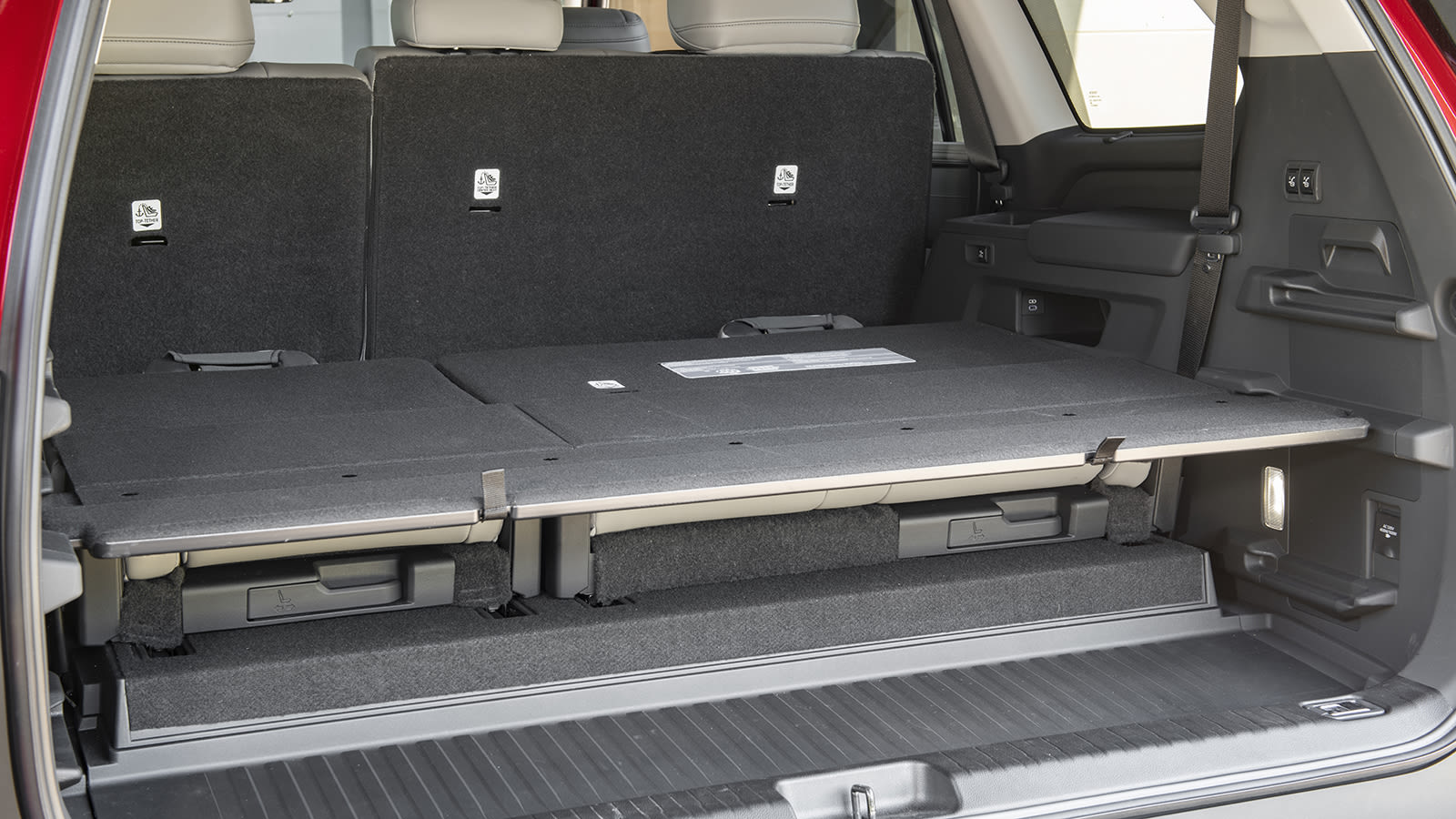At last year’s Toyota HQ Confidential summit, I had a chance to drive basically anything in the Toyota line-up. I took a Sequoia TRD Pro out on a short off-road course, and while capable, it was appalling how cheap, flimsy and old it felt. Not that it should’ve been a surprise. The Sequoia had been virtually unchanged since its 2008 debut – it had even missed out on the updates made to the Tundra pickup upon which it was based. The full redesign for the 2023 Toyota Sequoia is therefore extremely welcome. It’s vastly improved as far as the driving experience, build quality, materials and technology. That’s the good news. The bad news is that it remains well behind the full-size SUV leaders in several key factors.
As before, the new Sequoia is mechanically related to the Tundra, which includes its hybrid twin-turbo 3.5-liter V6. It makes the same 437 horsepower and 583 pound-feet of torque, and is mated to the same 10-speed automatic transmission. Rear-wheel-drive and four-wheel drive are available, and every Sequoia comes standard with a limited-slip rear differential. An electronic locking rear differential is available.
Unlike the Tundra, though, the hybrid is the only powertrain. Official fuel economy numbers haven’t been announced, but Toyota said it should be similar to the hybrid Tundra. That should put it around 20 to 22 mpg combined depending on drivetrain and trim level (the TRD Pro with its lack of air dam and slightly taller ride height doesn’t exactly have great aerodynamics). Towing capacity maxes out at 9,500 pounds.
Also, while the platform, including its fully-boxed frame, is derived from the Tundra, the Sequoia gets a multilink solid rear suspension with multiple options to enhance it for specific purposes. A rear load-leveling air suspension is available on fancier trims; the TRD Sport package tunes the suspension for better on-road handling; the TRD Off-Road package gets Bilstein shocks and springs for better off-road capability; and the TRD Pro (pictured above) goes even further with Fox shocks and its own unique springs.
Among those specs are a few highlights. Compared to its key rivals, the Chevy Tahoe/GMC Yukon, Ford Expedition and Jeep Wagoneer, the Sequoia boasts the most torque, the best fuel economy and the most towing capacity of any of those gas-powered SUVs. The exception being the diesel Tahoe, which can manage 22 to 24 mpg combined, but does take more expensive fuel and makes significantly less power.
There are some highlights on the road, too. The hybrid V6 is superb. It’s incredibly smooth and quiet, or at least extremely well insulated from the cabin. The cabin in general is very quiet, particularly higher trims with the additional acoustic glass. Press the throttle, and the electric motor and turbo engine coordinate to provide smooth, effortless torque, which keeps coming all through the rev range. Push it harder, and you get a deep, throaty growl. It’s even louder in the TRD Pro, which gets a cat-back exhaust. It thankfully doesn’t change the tone, and the volume remains low enough to not annoy yourself or your neighbors. And considering the droney, nasal noises other V6s (looking at you F-150 Raptor and 4Runner TRD Pro, among others), this is quite impressive. Furthermore, the smart, gentle-shifting automatic doesn’t bring attention to itself. The only exception is the occasional double-downshift due to its many ratios, but it’s still a step above Ford’s often out-of-step transmissions.
Ride quality is another excellent aspect of the Sequoia. The chassis in particular feels ultra-solid, and there are hardly any of the wiggles and shimmies found in other body-on-frame full-size SUVs. The suspension tuning is quite soft, but isn’t overly floaty, and it remains stable over bumps. Off-road, the regular Sequoia with the TRD Off-Road package is capable, though the softness has trouble dealing with abrupt bumps and higher speeds. That’s where the TRD Pro comes in with its stiffer suspension tuning that makes it very fun on faster dirt paths. The TRD Pro’s off-road tires, added skid plate and deleted aero spoiler are also helpful off road.
But now we arrive at the list of many Sequoia shortcomings. First of all is handling. Even at the low bar set by full-size SUVs, the Sequoia feels rather barge-like. The steering is light, vague and slow. Frequent corrections are required to go straight as well as maintain a line through corners. The soft suspension results in lots of body roll, and it feels like there’s a delay between steering inputs and the SUV’s reactions. A Tahoe or Yukon can feel borderline fun to steer; the Sequoia definitely does not.
Then there’s the interior. It’s a great transformation compared to its predecessor, and has a nice, chunky design. The modern Toyota infotainment system is also bright, responsive and simple, particularly on the 14-inch touchscreen that comes on most Sequoia trim levels. The materials are certainly much better than before, but they’re only just on par with Ford and GM on the low to mid trims. The range-topping Capstone (pictured below) features niceties such as semi-aniline leather and walnut wood trim, but there are enough of the basic plastic components poking through that it doesn’t feel as nice as an Expedition Platinum, Yukon Denali or Wagoneer Series III.
Interior comfort and usability is another problem. The front seats are spacious in every which way, and the seats are reasonably comfortable if a bit flat. But each following row has flatter and firmer seats that feel less comfortable than those in the competition. The third row in particular is disappointing. The rock-hard bench sits low on the floor, and despite the fact that it uniquely slides, legroom is always tight. So is headroom. So while adults can fit, they won’t want to be back there long. Compare that to the third rows of the Expedition, Tahoe and Jeep Wagoneer, which can comfortably accommodate even 6-footers for as long as you need. At least access is fairly easy due to the tumble-forward second-row seats.
The biggest interior issue, however, is cargo space. The third-row seats can slide forward slightly, but they cannot be removed, nor can they fold flat into the floor. This is because, according to someone from Toyota, the hybrid battery pack sits under the third row, and leaving it in place provides an extra layer of protection. However, just because there’s a reason for a problem doesn’t mean it’s not a problem. The odd, terraced space is poorly suited to carrying long, bulky objects, and although there is an adjustable cargo shelf available that creates a flat-load floor, the vertical space provided is dramatically less than what you’d find elsewhere. The lift-in height is comically high, too.
Space behind the third row is also compromised. It can be as much as 22.3 cubic feet, which is comparable to the Tahoe/Yukon, Expedition and Wagoneer, but to get that, you have to slide the third row all the way forward, making it basically useless. Move it all the way back and the space shrinks to 11.5 cubic feet, which would be less than a Mitsubishi Outlander. And while the American SUVs have long variants, the Sequoia is available in one body style only.
Then we come to pricing. The Sequoia starts at $59,795, including the destination charge. That’s between $5,000 and $6,000 more than the Ford and Chevy. The TRD Pro’s $78,395 price tag also comes well above the Expedition Timberline and Tahoe Z71, even when the latter is outfitted with the optional 6.2-liter V8 and adaptive air and magnetic suspension. To be fair, the TRD Pro comes with a number of standard features that likely make it more capable than the Americans off road, such as the electronic locking rear differential, Fox shocks and Crawl Control (off-road cruise control). The Capstone comes in at $76,795 with the standard two-wheel drive. That puts it a couple thousand north of the Tahoe High Country, and and few thousand below the top Ford Expedition Platinum. It’s basically even with the range-topping Wagoneer, but well short of the much fancier Grand Wagoneer.
If you’re a Sequoia owner or fan that’s been waiting for a truly new example of the model to trade up to, your SUV is finally here. It’s a galactic leap ahead of the outgoing model and will surely make existing owners happy. But if you have no loyalties to Toyota, the fact is that the American benchmarks remain the best all-around packages for the person that needs a do-it-all SUV for hauling people and stuff in comfort and more.
(Correction: A previous version of this story stated the Sequoia had an independent rear suspension. It’s actually a solid rear axle. The text has been updated to the corrrect information.)
Related Video:
Source: www.autoblog.com


